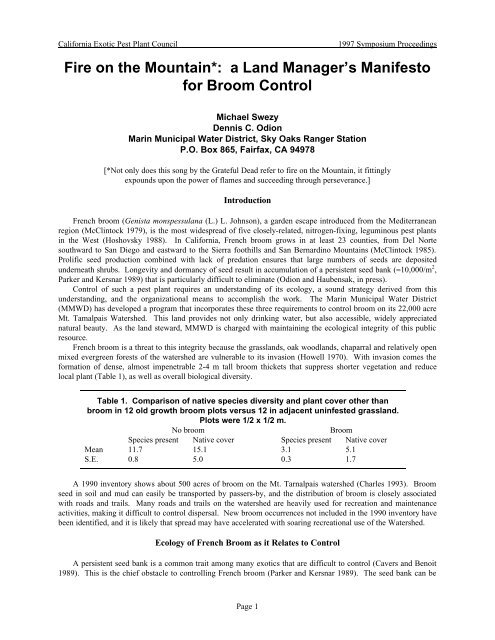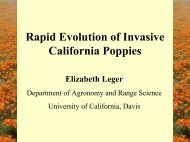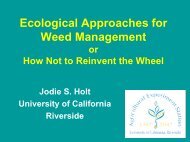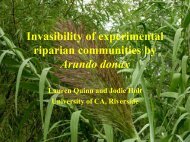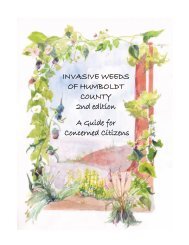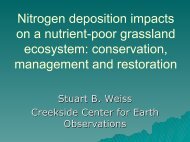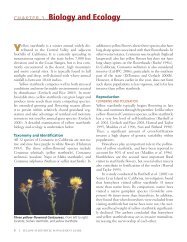Fire on the Mountain*: a Land Manager's Manifesto for ... - Cal-IPC
Fire on the Mountain*: a Land Manager's Manifesto for ... - Cal-IPC
Fire on the Mountain*: a Land Manager's Manifesto for ... - Cal-IPC
Create successful ePaper yourself
Turn your PDF publications into a flip-book with our unique Google optimized e-Paper software.
<strong>Cal</strong>i<strong>for</strong>nia Exotic Pest Plant Council1997 Symposium Proceedings<str<strong>on</strong>g>Fire</str<strong>on</strong>g> <strong>on</strong> <strong>the</strong> <strong>Mountain*</strong>: a <strong>Land</strong> Manager’s <strong>Manifesto</strong><strong>for</strong> Broom C<strong>on</strong>trolMichael SwezyDennis C. Odi<strong>on</strong>Marin Municipal Water District, Sky Oaks Ranger Stati<strong>on</strong>P.O. Box 865, Fairfax, CA 94978[*Not <strong>on</strong>ly does this s<strong>on</strong>g by <strong>the</strong> Grateful Dead refer to fire <strong>on</strong> <strong>the</strong> Mountain, it fittinglyexpounds up<strong>on</strong> <strong>the</strong> power of flames and succeeding through perseverance.]Introducti<strong>on</strong>French broom (Genista m<strong>on</strong>spessulana (L.) L. Johns<strong>on</strong>), a garden escape introduced from <strong>the</strong> Mediterraneanregi<strong>on</strong> (McClintock 1979), is <strong>the</strong> most widespread of five closely-related, nitrogen-fixing, leguminous pest plantsin <strong>the</strong> West (Hoshovsky 1988). In <strong>Cal</strong>i<strong>for</strong>nia, French broom grows in at least 23 counties, from Del Nortesouthward to San Diego and eastward to <strong>the</strong> Sierra foothills and San Bernardino Mountains (McClintock 1985).Prolific seed producti<strong>on</strong> combined with lack of predati<strong>on</strong> ensures that large numbers of seeds are depositedunderneath shrubs. L<strong>on</strong>gevity and dormancy of seed result in accumulati<strong>on</strong> of a persistent seed bank (≈10,000/m 2 ,Parker and Kersnar 1989) that is particularly difficult to eliminate (Odi<strong>on</strong> and Haubensak, in press).C<strong>on</strong>trol of such a pest plant requires an understanding of its ecology, a sound strategy derived from thisunderstanding, and <strong>the</strong> organizati<strong>on</strong>al means to accomplish <strong>the</strong> work. The Marin Municipal Water District(MMWD) has developed a program that incorporates <strong>the</strong>se three requirements to c<strong>on</strong>trol broom <strong>on</strong> its 22,000 acreMt. Tamalpais Watershed. This land provides not <strong>on</strong>ly drinking water, but also accessible, widely appreciatednatural beauty. As <strong>the</strong> land steward, MMWD is charged with maintaining <strong>the</strong> ecological integrity of this publicresource.French broom is a threat to this integrity because <strong>the</strong> grasslands, oak woodlands, chaparral and relatively openmixed evergreen <strong>for</strong>ests of <strong>the</strong> watershed are vulnerable to its invasi<strong>on</strong> (Howell 1970). With invasi<strong>on</strong> comes <strong>the</strong><strong>for</strong>mati<strong>on</strong> of dense, almost impenetrable 2-4 m tall broom thickets that suppress shorter vegetati<strong>on</strong> and reducelocal plant (Table 1), as well as overall biological diversity.Table 1. Comparis<strong>on</strong> of native species diversity and plant cover o<strong>the</strong>r thanbroom in 12 old growth broom plots versus 12 in adjacent uninfested grassland.Plots were 1/2 x 1/2 m.No broomBroomSpecies present Native cover Species present Native coverMean 11.7 15.1 3.1 5.1S.E. 0.8 5.0 0.3 1.7A 1990 inventory shows about 500 acres of broom <strong>on</strong> <strong>the</strong> Mt. Tarnalpais watershed (Charles 1993). Broomseed in soil and mud can easily be transported by passers-by, and <strong>the</strong> distributi<strong>on</strong> of broom is closely associatedwith roads and trails. Many roads and trails <strong>on</strong> <strong>the</strong> watershed are heavily used <strong>for</strong> recreati<strong>on</strong> and maintenanceactivities, making it difficult to c<strong>on</strong>trol dispersal. New broom occurrences not included in <strong>the</strong> 1990 inventory havebeen identified, and it is likely that spread may have accelerated with soaring recreati<strong>on</strong>al use of <strong>the</strong> Watershed.Ecology of French Broom as it Relates to C<strong>on</strong>trolA persistent seed bank is a comm<strong>on</strong> trait am<strong>on</strong>g many exotics that are difficult to c<strong>on</strong>trol (Cavers and Benoit1989). This is <strong>the</strong> chief obstacle to c<strong>on</strong>trolling French broom (Parker and Kersnar 1989). The seed bank can bePage 1
<strong>Cal</strong>i<strong>for</strong>nia Exotic Pest Plant Council1997 Symposium Proceedingsexhausted by germinati<strong>on</strong> and mortality. Nei<strong>the</strong>r will occur at appreciable rates without procedures to enhance<strong>the</strong>m - dormancy of most seed can <strong>on</strong>ly be broken by heat, and dormant seed is l<strong>on</strong>g-lived based <strong>on</strong> in<strong>for</strong>mati<strong>on</strong>about closely related species. Scotch broom seeds remain viable <strong>for</strong> at least 80 years (Turner 1933), and manyo<strong>the</strong>r legume seeds are known to have much greater l<strong>on</strong>gevity (Baker 1989). Since <strong>the</strong>re is no o<strong>the</strong>r practicablemeans of treating seed to reduce <strong>the</strong> seed bank, c<strong>on</strong>trol of broom will require fire <strong>on</strong> <strong>the</strong> Mountain.Odi<strong>on</strong> and Haubensak (in press), studied resp<strong>on</strong>se of French broom seed banks to burning. In mixedannual/native grassland <strong>on</strong> <strong>the</strong> watershed, 1-2 in tall, 5-10 year old broom stands had 500-4300 seeds/m 2 .Burning cut stands with <strong>the</strong> additi<strong>on</strong> of slash fuel significantly increased germinati<strong>on</strong>, and following a sec<strong>on</strong>dburn 1 year later, emergence was reduced to low levels. In c<strong>on</strong>trast, 2-3 in tall, 15-25 year old stands had4,300-14,000 seeds/m 2 , with a sizable porti<strong>on</strong> too deeply buried to be killed or induced to germinate using firetreatments.Grassland soils invaded by broom also had significantly more available nitrogen than soils in uninvadedplots. After burning, broom invaded areas remained enriched. Soil nitrogen enrichment is a c<strong>on</strong>cern because ithas been documented in many cases, going back to <strong>the</strong> work of Lawes and Gilbert in 1880 (see Vitousek et al.1997), that this may shift dominance to nitrogen demanding plants. Thus, French broom may alter sites to bemore favorable to fast growing, weedy plants, and it is uncertain how to ameliorate this.Broom C<strong>on</strong>trol StrategyThe most important c<strong>on</strong>clusi<strong>on</strong> from this research is that as broom stands age (Fig. 1), seed accumulati<strong>on</strong> atgreater soil depths will cause a transiti<strong>on</strong> from an infestati<strong>on</strong> that may be possible to c<strong>on</strong>trol with fuel additi<strong>on</strong>,repeat burning and follow up treatments, to <strong>on</strong>e that will require chr<strong>on</strong>ic treatment indefinitely to eliminateemerging plants. Un<strong>for</strong>tunately, most broom infestati<strong>on</strong>s <strong>on</strong> <strong>the</strong> watershed have already underg<strong>on</strong>e thistransiti<strong>on</strong>. There<strong>for</strong>e, we developed a two-pr<strong>on</strong>ged management strategy, <strong>on</strong>e <strong>for</strong> dealing with a resilient landailment and ano<strong>the</strong>r <strong>for</strong> preventing infestati<strong>on</strong>s from becoming a resilient ailment.Fig. 1. Changes in French broom seed bank with time.<str<strong>on</strong>g>Fire</str<strong>on</strong>g> is needed to c<strong>on</strong>trol both young and old stands because it depletes <strong>the</strong> seed bank. It also c<strong>on</strong>trolsresprouting if repeated every 1-4 years, so that regenerating broom does not reach reproductive age. <str<strong>on</strong>g>Fire</str<strong>on</strong>g> costsrelatively little, provides additi<strong>on</strong>al ecological benefits, and does not raise toxicological c<strong>on</strong>cerns. MMWD hasnot c<strong>on</strong>sidered methods of pois<strong>on</strong>ing seed, or <strong>the</strong> soil that seedlings emerge through, because <strong>the</strong>se have broadspectrum biocidal impacts that are unacceptable <strong>on</strong> Watershed lands. The same would apply in most wildlandsettings. O<strong>the</strong>r methods of eliminating existing broom stands (Table 2) have little effect <strong>on</strong> <strong>the</strong> seed bank.Herbicides are listed am<strong>on</strong>g broom killing tools in Table 2 because <strong>the</strong>y will be an opti<strong>on</strong> <strong>for</strong> many landmanagers. MMWD policy prohibits using <strong>the</strong>se chemicals <strong>on</strong> lands draining into reservoirs, and, due to publicsentiment, avoids any broadcast applicati<strong>on</strong> <strong>on</strong> o<strong>the</strong>r lands it manages.With prescribed fire, <strong>the</strong>re is <strong>the</strong> risk of escape and of causing unintended mortality of n<strong>on</strong>-sproutingc<strong>on</strong>ifers (Swezy and Agee 1991). There are also negative effects from repeat and out-of seas<strong>on</strong> burning inPage 2
<strong>Cal</strong>i<strong>for</strong>nia Exotic Pest Plant Council1997 Symposium Proceedingschaparral (Zedler et al. 1983, Parker 1987). Because of <strong>the</strong>se c<strong>on</strong>cerns, we have made chaparral infested areasa lower priority than mixed evergreen <strong>for</strong>est and grasslands, where fire as frequent as needed <strong>for</strong> broom c<strong>on</strong>trolappears to have no unwanted side-effects.Preventing Fur<strong>the</strong>r SpreadEliminating broom infestati<strong>on</strong>s be<strong>for</strong>e <strong>the</strong>y become resilient will be critical to l<strong>on</strong>g-term c<strong>on</strong>trol. Parametersin <strong>the</strong> model shown in Figure 1 need to be refined to predict at what point <strong>the</strong> critical transiti<strong>on</strong> in <strong>the</strong> seed bankoccurs and to identify sites that can be restored now, but that will become inveterate infestati<strong>on</strong>s if treatment isdelayed. The repeat bum method with initial pulling or cutting, and fuel additi<strong>on</strong> will be effective <strong>for</strong> sufficientlyyoung infestati<strong>on</strong>s.Road grading, trail work, and o<strong>the</strong>r maintenance activities may disperse seed. Limiting or stopping use ofroads and trails in infested areas during muddy c<strong>on</strong>diti<strong>on</strong>s would be a beneficial preventi<strong>on</strong> strategy, but may beimpossible <strong>for</strong> MMWD and o<strong>the</strong>r public land managers in central and nor<strong>the</strong>rn <strong>Cal</strong>i<strong>for</strong>nia because of <strong>the</strong> public'srecreati<strong>on</strong>al demands.Table 2. Properties of Broom Tools Used by Marin Municipal Water DistrictCost (approx.Tool Advantages Disadvantagesretail)hand pulling Good <strong>for</strong> small plants in moist Limited seas<strong>on</strong> and size. Strains labor cost <strong>on</strong>lyc<strong>on</strong>diti<strong>on</strong>sback.Pulaski<str<strong>on</strong>g>Fire</str<strong>on</strong>g>fighting tool good <strong>for</strong> grubbing Disturbs soil. Not appropriate in $25-$45out gnarly root masses.most cases.Root Jack Efficient hand puller. Light weightand portable.Can't attach to really large stemsWooden handle breaks <strong>on</strong> tough$90Weed WrenchBrushcutter(weed whip)chain sawpropane torchw/flame spreaderflail mowertractor-mountedbrush cutterexcavatormountedprescribed fireHeavy duty, powerful hand puller.Variety of sizes.Good <strong>for</strong> cutting shrubs close to <strong>the</strong>ground. Useful <strong>for</strong> small stems andseedlings.Good <strong>for</strong> cutting <strong>on</strong> steeper slopesand <strong>for</strong> larger stems. Cuts quickly.N<strong>on</strong>-toxic technique <strong>for</strong> roadsideseedlings.Very productive <strong>for</strong> mowingroadside plants.Can travel off of roads. Low groundpressure. Excellent pre-treatment<strong>for</strong> prescribed burning.Only method that reduces seed bank.Can benefit natives.plants.Larger sizes are heavy to carry.Doesn't attach to stems as easily asRoot Jack but holds tighter.Difficult to use <strong>on</strong> steep ground.Cuts slower than a chain saw.Dangerous, need safety gear.Not good <strong>for</strong> smaller stems. Backstrain to cut low. Dangerous, needsafety gear.<str<strong>on</strong>g>Fire</str<strong>on</strong>g> hazard, limited to wet seas<strong>on</strong>.Not very portable off of road.Sprouts require retreatment at2-year interval. Can't go off ofroads.Limited to slopes less than 35%slope. Can't maneuver betweentrees. Must treat stump sprouts.May require pre-treatment.Escapes are a possibility. Notappropriate in all locati<strong>on</strong>s.$50-$150commercial grade$500-$600$250-$500$150$50,000$100-$150,000$50-$400/acreHerbicide Efficient, easy. See DiTomaso* Toxicology c<strong>on</strong>cerns. See variableDiTomaso*bio-c<strong>on</strong>trol Benign Not effective <strong>for</strong> broom. research isexpensive*Proceedings. 1997. <strong>Cal</strong>i<strong>for</strong>nia Exotic Pest Plant Council Symposium, Vol. III.Page 3
<strong>Cal</strong>i<strong>for</strong>nia Exotic Pest Plant Council1997 Symposium ProceedingsC<strong>on</strong>taminated soil may be inadvertently distributed by o<strong>the</strong>r activities. Broom seeds float, and <strong>the</strong>re<strong>for</strong>e maysettle out and accumulate in reservoirs (Hoshovsky 1988). This seed may be redistributed in dredging spoils if <strong>the</strong>yare not carefully handled and disposed of. Similarly, debris flow and landslide deposits removed from roads maybe c<strong>on</strong>taminated, as evidenced by <strong>the</strong> broom that comm<strong>on</strong>ly emerges from <strong>the</strong>m when stockpiled.Successfully c<strong>on</strong>trolling <strong>the</strong> spread of broom and eliminati<strong>on</strong> of young stands will require development of anenduring instituti<strong>on</strong> to organize and deliver treatments indefinitely. Such an instituti<strong>on</strong> is also integral to <strong>the</strong>strategy <strong>for</strong> dealing with old stands.Attacking Inveterate StandsThe need <strong>for</strong> l<strong>on</strong>g-term organizati<strong>on</strong> and planning to deal with an inveterate land ailment has been illustratedby MMWD's experience. In <strong>the</strong> 1980s, some areas were burned <strong>on</strong>ce or twice, and <strong>the</strong>n burning <strong>for</strong> broom c<strong>on</strong>trolwas largely disc<strong>on</strong>tinued until recently due to public c<strong>on</strong>troversy regarding fire effects. Infestati<strong>on</strong>s at <strong>the</strong>se earlyburn areas became worse as a result of disc<strong>on</strong>tinuing burning treatment. Where burning has c<strong>on</strong>tinued since <strong>the</strong>1980s <strong>on</strong> <strong>the</strong> perimeter of <strong>on</strong>e reservoir, broom cover has been <strong>for</strong> <strong>the</strong> most part c<strong>on</strong>trolled, but burning every 2-4years has been required, and significant emergence c<strong>on</strong>tinues. Thus, it is critical <strong>for</strong> <strong>the</strong> land manager to developa burn rotati<strong>on</strong> schedule that can be followed indefinitely, and that will optimize acreage that can be treatedwithout compromising effectiveness. Areas should be burned frequently enough to prevent any flowering/seedproducti<strong>on</strong>. Under prescribed bum c<strong>on</strong>diti<strong>on</strong>s, broom may not burn unless mixed with more combustible fuels, sosites will have to be pre-treated accordingly. Cutting or pulling broom and allowing it to cure is <strong>the</strong> strategyemployed by MMWD. Arranging <strong>the</strong> various labor sources to per<strong>for</strong>m this work so that it meshes with <strong>the</strong> burnschedule complicates planning.Once <strong>the</strong> burn rotati<strong>on</strong> schedule has been developed, it will be possible to determine whe<strong>the</strong>r treatment of newareas can be achieved. The most important infestati<strong>on</strong>s to treat should be prioritized based <strong>on</strong> <strong>the</strong> principlesdescribed in <strong>the</strong> following secti<strong>on</strong>.Using <str<strong>on</strong>g>Fire</str<strong>on</strong>g> Management Principles to Establish PrioritiesProfessi<strong>on</strong>al fire management organizati<strong>on</strong>s have developed effective strategies <strong>for</strong> reducing <strong>the</strong> negativeimpacts of wildfires. These strategies are relevant to managing French broom invasi<strong>on</strong> in wildlands (Dewey1995). We adapted <strong>the</strong> following principles from fire management strategies:1. Attack newly discovered populati<strong>on</strong>s swiftly and aggressively. In fire management, <strong>the</strong> shorter <strong>the</strong> periodbetween discovery and initial attack, <strong>the</strong> smaller <strong>the</strong> final fire size.2. Focus ef<strong>for</strong>ts <strong>on</strong> stopping <strong>the</strong> spread of invasives be<strong>for</strong>e expending resources attacking well-entrenched stands.3. Protect <strong>the</strong> most vulnerable plant communities such as woodlands and grasslands.4. Protect high value areas: scenic areas, areas of heavy public use, and areas with high habitat value.5. When resources are scarce, let some areas go until techniques are refined or more resources are available.This course is realistic and psychologically healthy.6. Take <strong>on</strong> <strong>on</strong>ly what you are committed to manage <strong>for</strong> <strong>the</strong> l<strong>on</strong>g-term or risk failure and despair.7. Follow-up treatments must be thorough and persistent. Mopping-up after wildfires are c<strong>on</strong>trolled is tediousbut absolutely necessary. Without it, fires can rekindle and suppressi<strong>on</strong> activities must begin again.The Broom-Killing Organizati<strong>on</strong>At MMWD, creati<strong>on</strong> of <strong>the</strong> organizati<strong>on</strong>al means to c<strong>on</strong>trol broom began with <strong>the</strong> development of <strong>the</strong> Mt.Tamalpais Area Vegetati<strong>on</strong> Management Plan in 1994. This plan has <strong>the</strong> dual aims of reducing fire hazard andprotecting biodiversity. <strong>Land</strong> managers throughout <strong>Cal</strong>i<strong>for</strong>nia are faced with <strong>the</strong>se c<strong>on</strong>cerns, which can effectivelybe addressed with comprehensive planning. For example, much of MMWD's fire hazard reducti<strong>on</strong> c<strong>on</strong>sists ofestablishing a system of fuel breaks (vegetati<strong>on</strong> is thinned al<strong>on</strong>g roads to create defensible space). Thesetreatments have been designed to achieve fuel reducti<strong>on</strong> and broom c<strong>on</strong>trol in <strong>the</strong> same locati<strong>on</strong>s. Becausefollow-up treatment will occur regularly, broom "c<strong>on</strong>trol" should be achieved in fuel break areas.Page 4
<strong>Cal</strong>i<strong>for</strong>nia Exotic Pest Plant Council1997 Symposium ProceedingsGuidelines <strong>for</strong> a Broom-Killing Organizati<strong>on</strong>Implementati<strong>on</strong> of <strong>the</strong> plan began in earnest in 1995 with <strong>the</strong> hiring of a professi<strong>on</strong>al resource managementstaff. The operati<strong>on</strong>al premise adopted by this staff was that <strong>the</strong> major challenge <strong>for</strong> broom c<strong>on</strong>trol is anorganizati<strong>on</strong>al <strong>on</strong>e. L<strong>on</strong>g-term c<strong>on</strong>trol must rely <strong>on</strong> extensive landscape applicati<strong>on</strong>s repeated indefinitely,requiring an enduring organizati<strong>on</strong> to deliver <strong>the</strong>m. But, with budgetary and o<strong>the</strong>r c<strong>on</strong>straints, how does a landmanager sustain a l<strong>on</strong>g-term ef<strong>for</strong>t over a large area? MMWD established <strong>the</strong>se guidelines to direct <strong>the</strong>development of its broom killing organizati<strong>on</strong>.1. Create a thinking bureaucracy. By incorporating m<strong>on</strong>itoring and research into broom c<strong>on</strong>trol activities,effectiveness can be measured and strategies and techniques can be refined.2. Create organizati<strong>on</strong>al commitment. Communicating <strong>the</strong> perils of broom and realities of c<strong>on</strong>trol todecisi<strong>on</strong>-makers of land agencies can achieve this. Early in <strong>the</strong> implementati<strong>on</strong> of MMWD's plan,presentati<strong>on</strong>s were made to <strong>the</strong> elected Board of Directors emphasizing <strong>the</strong> need <strong>for</strong> sustained instituti<strong>on</strong>alsupport. Regular updates are provided to keep <strong>the</strong> issue at <strong>the</strong> <strong>for</strong>efr<strong>on</strong>t.3. Create organizati<strong>on</strong>al structure. At MMWD, <strong>the</strong> supervisors of work crews involved in vegetati<strong>on</strong>management were trained in MMWD's broom-c<strong>on</strong>trol techniques. Various low-cost labor sources have beenemployed in broom removal projects under <strong>the</strong> directi<strong>on</strong> of <strong>the</strong>se supervisors. Also, projects will beincorporated into MMWD's "maintenance work-order system," a computer database that schedules tasksand tracks accomplishments <strong>for</strong> work sites. This final step will provide <strong>the</strong> structure <strong>for</strong> managing broomproject sites over <strong>the</strong> l<strong>on</strong>g-term.4. Build partnership with <strong>the</strong> community. Participati<strong>on</strong> of MMWD in broom c<strong>on</strong>trol with <strong>the</strong> localcommunity has many benefits. In<strong>for</strong>med citizens will be more likely to support restorati<strong>on</strong>. Participati<strong>on</strong>gives <strong>the</strong> public a stake in management based <strong>on</strong> real c<strong>on</strong>tributi<strong>on</strong>s <strong>on</strong> <strong>the</strong> ground. Finally, a volunteer work<strong>for</strong>ce can provide a significant amount of labor.To help build partnerships with <strong>the</strong> community in Marin, <strong>the</strong> public needed to be in<strong>for</strong>med of <strong>the</strong> vegetati<strong>on</strong>management plan and <strong>the</strong> broom strategy. Presentati<strong>on</strong>s were made to interested community groups. Am<strong>on</strong>thly tour of <strong>the</strong> watershed was instituted <strong>for</strong> elected local officials, local agency staff, envir<strong>on</strong>mentalgroups, watershed user groups, and o<strong>the</strong>r interested citizens.Many agencies/landowners have already established <strong>for</strong>mal volunteer programs. The development of aMMWD's <strong>for</strong>mal volunteer program in 1996 opened <strong>the</strong> door to a variety of community volunteers andschool groups. A <strong>on</strong>ce-a-m<strong>on</strong>th habitat restorati<strong>on</strong> program was initiated. A <strong>on</strong>e-day school broom pullingevent <strong>for</strong> 250 elementary school students at B<strong>on</strong> Tempe Lake has become a regular annual field trip <strong>for</strong> localelementary schools. Church groups, middle and high school service projects, university interns andinterested individuals have participated in some aspect of broom c<strong>on</strong>trol <strong>on</strong> <strong>the</strong> watershed.5. Create mythology to sustain participants. The restorati<strong>on</strong> of broom-infested areas is truly heroic interms of <strong>the</strong> resources at risk and <strong>the</strong> geographic and temporal scales under which c<strong>on</strong>trol may be achieved.By blending humor with inspirati<strong>on</strong>al messages via such media as public presentati<strong>on</strong>s, news releases,brochures and newsletters, a mythology can be developed that gives weed warriors greater understanding of<strong>the</strong> purpose of <strong>the</strong>ir work. This understanding can sustain spirits in <strong>the</strong> face of <strong>the</strong> mundane task of pullingbroom.MMWD staff created <strong>the</strong> "Broom Free Press," a newsletter, to acquaint volunteers with <strong>the</strong> basics of broomecology. Butt<strong>on</strong>s with <strong>the</strong> slogan "Broom Free by 2003" surrounding MMWD's Mt. Tarnalpais logo weredistributed to volunteers. A banner headlined article in <strong>the</strong> local newspaper urged volunteers to help c<strong>on</strong>trolbroom (Moses 1996). It quoted staff -- "an ecological disaster is brewing in <strong>the</strong> hills of Marin County."Finally, a watershed ranger wrote a poem that inspires volunteers.6. Encourage diversity in all aspects of <strong>the</strong> organizati<strong>on</strong>. We believe that diversity adds stability to anorganizati<strong>on</strong>. We have used a variety of labor sources, tools and techniques (Table 2), and strategies inorder to increase learning and to wea<strong>the</strong>r failures. For instance, MMWD has employed staff, MarinC<strong>on</strong>servati<strong>on</strong> Corps, <strong>Cal</strong>i<strong>for</strong>nia C<strong>on</strong>servati<strong>on</strong> Corps, Marin and S<strong>on</strong>oma County Probati<strong>on</strong> Departments,community service workers, County jail inmates, and San Quentin Boot Camp inmates. Inmate andPage 5
<strong>Cal</strong>i<strong>for</strong>nia Exotic Pest Plant Council1997 Symposium Proceedingsprobati<strong>on</strong> workers provided approximately $320,000 of unpaid labor in a two year period. When <strong>the</strong> BootCamp program was closed we suffered a loss in producti<strong>on</strong>, but broom c<strong>on</strong>trol c<strong>on</strong>tinued unabated.C<strong>on</strong>clusi<strong>on</strong>s and Recommendati<strong>on</strong>sThe ef<strong>for</strong>ts described above provide <strong>the</strong> foundati<strong>on</strong> <strong>for</strong> a l<strong>on</strong>g-term broom c<strong>on</strong>trol program. The ultimatetest is whe<strong>the</strong>r or not we can sustain labor requirements indefinitely. Developing a more vibrant volunteerprogram is a high priority. A promising community link is working with school groups to include exotic speciesc<strong>on</strong>trol in envir<strong>on</strong>mental educati<strong>on</strong> curricula accompanied by field trips.A large porti<strong>on</strong> of <strong>the</strong> broom c<strong>on</strong>trol ef<strong>for</strong>t will require large work crews, equipment, and prescribed fire,which will remain independent of school children and volunteers. Funding such ef<strong>for</strong>ts from rate payer revenuesmay be increasingly difficult in <strong>the</strong> future. The Golden Gate Nati<strong>on</strong>al Parks Associati<strong>on</strong> has proven to be asuccessful model <strong>for</strong> using private d<strong>on</strong>ati<strong>on</strong>s to fund a sophisticated volunteer auxiliary <strong>for</strong>ce <strong>for</strong> Golden GateNati<strong>on</strong>al Recreati<strong>on</strong> Area’s (GGNRA) resource management ef<strong>for</strong>ts. GGNRA's volunteer program alsosatisfies <strong>the</strong> park's goals of communitybased restorati<strong>on</strong> (Halloran 1996). In order to allow private c<strong>on</strong>tributi<strong>on</strong>s<strong>for</strong> <strong>the</strong> management and protecti<strong>on</strong> of natural resources of <strong>the</strong> Mt. Tamalpais Watershed, MMWD <strong>for</strong>med <strong>the</strong>Mt. Tamalpais Watershed Fund in 1996.Pris<strong>on</strong> crews are ano<strong>the</strong>r important source of labor. MMWD was a <strong>for</strong>tunate beneficiary of <strong>the</strong> San QuentinBoot Camp's work <strong>for</strong>ce. This pilot military-style, alternative sentencing program ended in 1997 when it failedto gain funding <strong>for</strong> implementati<strong>on</strong> of a permanent program. Using service <strong>on</strong> public lands as an object less<strong>on</strong> ina boot camp style inmate rehabilitati<strong>on</strong> program was unique and effective. This approach needs to developedwidely.Ano<strong>the</strong>r uncharted fr<strong>on</strong>tier involves developing cooperative ef<strong>for</strong>ts am<strong>on</strong>g public land managers inc<strong>on</strong>trolling broom spread. By developing a regi<strong>on</strong>al strategy and sharing resources, agencies may realizeefficiencies. Also, a regi<strong>on</strong>al strategy may more effectively attack areas with rapid spread and protect sensitivehabitats.MMWD ef<strong>for</strong>ts <strong>on</strong> <strong>the</strong> Mt. Tamalpais watershed have dem<strong>on</strong>strated that small victories can be achieved inc<strong>on</strong>trolling a particularly difficult pest plant invasi<strong>on</strong> if work resources are allocated strategically and in a waythat reflects ecological understanding. The real test will be maintaining ef<strong>for</strong>ts <strong>on</strong> public lands with increasinglyscarce public m<strong>on</strong>ey. Without stable l<strong>on</strong>g-term funding all current ef<strong>for</strong>ts may be futile and large areas of <strong>the</strong>watershed may be put at risk <strong>for</strong> an ecological disaster.ReferencesBaker, H. G. 1989. Some aspects of <strong>the</strong> natural history of seed banks. in Leck, M.A., V. T. Parker, and R.L. Simps<strong>on</strong> eds. Ecology of Soil SeedBanks. San Diego: Academic Press; 9-21.Cavers, P. B. And D. L. Benoit. 1989. Seed banks in arable land. Pages 309-328, M. A. Leck, V. T. Parker, and R. L. Simps<strong>on</strong> (eds.) Ecology of SoilSeed Banks. Academic Press, San Diego, Ca., USA.Charles, L. and Associates. 1993. Mt. Tamalpais area vegetati<strong>on</strong> management plan. Prepared under c<strong>on</strong>tract <strong>for</strong> Marin Municipal Water District,Marin County, <strong>Cal</strong>i<strong>for</strong>nia. 326 pages. Appendices.Dewey, S.A. 1995. A biological wildfire: applying fundamentals of wildfire management to improve noxious weed c<strong>on</strong>trol. Publicati<strong>on</strong> AG 500. UtahState University Extensi<strong>on</strong>, Logan, UT 84322.Fuller, T.C. and G.D. Barbe. 1985. The Bradley method of eliminating exotic plants from natural reserves. Frem<strong>on</strong>tia 13(2):2425.Halloran, P. 1996. The greening of <strong>the</strong> Golden Gate: community-based restorati<strong>on</strong> at <strong>the</strong> Presidio of San Francisco. Restorati<strong>on</strong> and ManagementNotes. Vol 14: 2 (112-123).Hoshovsky, M. 1988. Broom abstract. The Nature C<strong>on</strong>servancy, San Francisco, Ca.Howell, J.T. 1970. Marin Flora- 2nd editi<strong>on</strong>. University of <strong>Cal</strong>i<strong>for</strong>nia Press, Berkeley, CA. 366 pp.McClintock, E. 1979. The weedy brooms - where did <strong>the</strong>y come from? Frem<strong>on</strong>tia 6(4):15-17.McClintock, E. 1985. Status reports <strong>on</strong> invasive weeds: brooms. Frem<strong>on</strong>tia 12(4):17-18.Moses, J.R. 1996 Broom Busters take <strong>on</strong> pesky shrub: volunteers urged to help. Marin Independent Journal. April 29, 1996. San Rafael, CA.Odi<strong>on</strong>, D. C., and K. A. Haubensak. In Press. Resp<strong>on</strong>se of French broom to fire. in <str<strong>on</strong>g>Fire</str<strong>on</strong>g> in <strong>Cal</strong>i<strong>for</strong>nia Ecosystems: Integrating Ecology, Preventi<strong>on</strong>,and Management. Internati<strong>on</strong>al Associati<strong>on</strong> of Wildland <str<strong>on</strong>g>Fire</str<strong>on</strong>g>, Fairfield, Wa., USA.Parker, V. T. 1987. Effects of wet-seas<strong>on</strong> management bums <strong>on</strong> chaparral vegetati<strong>on</strong>: implicati<strong>on</strong>s <strong>for</strong> rare species. Pages 233237 in T.S. Elias and J.Nels<strong>on</strong> editors. C<strong>on</strong>servati<strong>on</strong> and management of rare and endangered plants. <strong>Cal</strong>i<strong>for</strong>nia Native Plant Society, Sacramento, <strong>Cal</strong>i<strong>for</strong>nia.Parker, V. T. and R. Kersnar. 1989. Regenerati<strong>on</strong> potential in French broom, Cytisus ni<strong>on</strong>spessulanus, and its possible management. A report to <strong>the</strong><strong>Land</strong> Management Divisi<strong>on</strong> of <strong>the</strong> Marin Municipal Water District. 17 pages.Page 6
<strong>Cal</strong>i<strong>for</strong>nia Exotic Pest Plant Council1997 Symposium ProceedingsSwezy, D. M., and J. K. Agee. 1991. Prescribed-fire effects <strong>on</strong> fine-root and tree mortality in old-gro%%,th p<strong>on</strong>derosa pine. Canadian Journal ofForest Research 21: 626-634.Turner, J.H. 1933. The viability of seeds. Kew Bull. 1933(6):257269.Vitousek, P.M., J. D. Aber, R. W. Howarth, G. E. Likens, P. A. Mats<strong>on</strong>, D. W. Schindler, W. H. Schlesinger, and D. G. Tilman. 1997. Humanalterati<strong>on</strong> of <strong>the</strong> global nitrogen cycle: sources and c<strong>on</strong>sequences. Ecological Applicati<strong>on</strong>s 7: 737-750.Zedler, P. H., C. R. Gautier, and G. S. McMaster. 1983. Vegetati<strong>on</strong> change in resp<strong>on</strong>se to extreme events: <strong>the</strong> effect of a short interval between fires in<strong>Cal</strong>i<strong>for</strong>nia chaparral and coastal scrub. Ecology 64:809-818.Page 7


